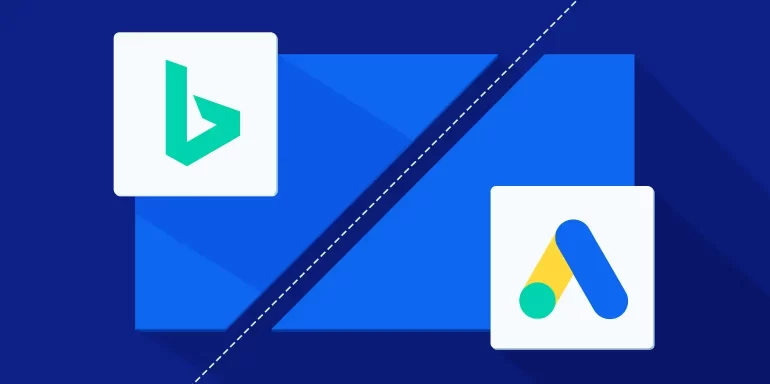When it comes to PPC advertising, it’s not uncommon to think: Bing Ads vs. Google Ads. On top of that:
- Which platform has more reach?
- Is Bing less expensive?
- Which has more targeting capabilities?
- Which will produce more conversions and revenue?
While many PPC advertisers view the two platforms as competitors, they actually work best hand-in-hand. Google undoubtedly has the majority of the search market, but Bing advertising certainly shouldn’t be forgotten. Rather than Google Ads vs. Bing Ads, marketers should be thinking Google Ads plus Bing Ads.
Let’s take a look at the relationship and dynamics between the two powerful advertising platforms; most importantly, how they’re best used together.
The difference between Google Ads and Bing Ads
The concept behind both platforms is the same. Both are pay-per-click advertising platforms designed to help businesses reach specific audiences, drive traffic, and increase revenue.
At the same time, each platform possesses specific features and benefits, making it unique and advantageous over the other.
Here’s a tidbit on each platform before we highlight the differences between the two.
Google Ads
Google Ads, is comprised of two advertising networks:
- The Search Network: Advertisers create text ads to appear on the search engine results page (SERP), example below
- The Display Network: Advertisers create display ads to appear on a vast number of websites across the internet
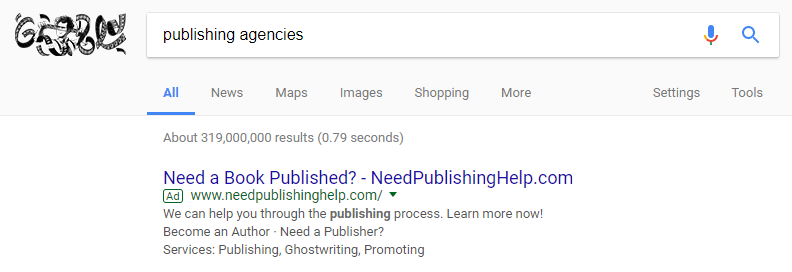
Bing Ads
Bing, which is owned by Microsoft, has three search engines — Bing, Yahoo, and AOL — so when you advertise on one platform, your ad is actually seen on all three. This opens up campaigns to searchers across all Bing, Yahoo, and AOL owned and operated sites, as well as various partner sites:
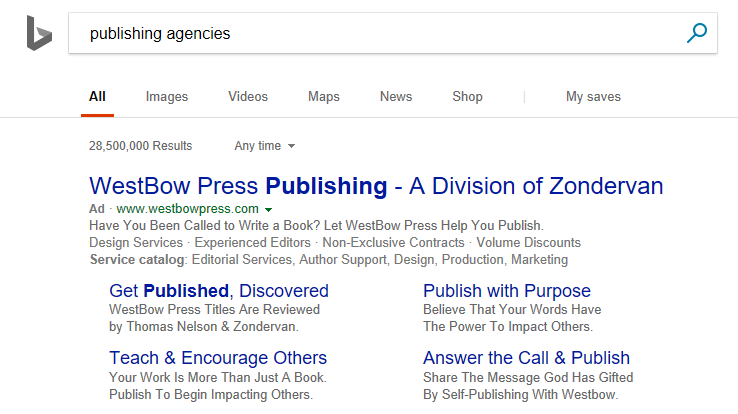
Bing Ads vs. Google Ads
Let’s see how Google Ads and Bing Ads compare in some basic aspects, such as display URLs, description text, keywords, and click-through rate.
Display URL
Google and Bing both show display URLs underneath the ad headline. Bing highlights their display URLs with bold formatting. Google Ads does not:
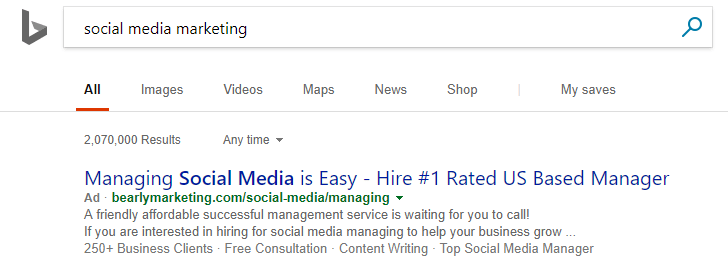

Description text
Previously, Google allowed two separate description lines limited to 35 characters each, and Bing offered one line with a maximum of 71 characters. Now, both Google and Bing allow 80 characters in one longer description field.
Keywords
Both Google and Bing offer a keyword research tool, broad match, and negative keyword targeting. The main difference between the two platforms is that the traffic volume for keywords is much lower on Bing.
Click-through rate
Since Yahoo and MSN both offer financial reporting, Bing ads tend to have higher CTRs for shopping and financial services search verticals. That’s because they offer many shopping and financial resources and ads in those search verticals on those platforms reach highly-interested prospects, receive more engagement, and have higher CTR.
This list didn’t mention reach or cost — two of the essential factors to consider when choosing an advertising platform. That’s because we feel they deserve their own sections.
Reach: Bing Ads vs. Google Ads
It’s well-known that Google has dominated the search engine market, and therefore has a larger search volume and more reach. By no means are they the only search engine worth investing in. The Bing network is growing quickly, too. Just take a look at the numbers:
- Bing now has 34% of the desktop search engine market share worldwide
- There are 5.4 billion monthly searches conducted on the Bing Network
- 136 million unique searchers use the Bing Network
Most importantly, Bing Ads reach 63 million searchers that aren’t reached with Google AdWords. So if you aren’t using Bing Ads, that’s a substantial amount of missed opportunity.
In addition to increased visibility, Bing allows advertisers to reach an older and more educated audience. As the pie chart shows, almost 40% of the Bing Network ranges from 35 to 54 years old, and nearly three-quarters of Bing users are over the age of 35:
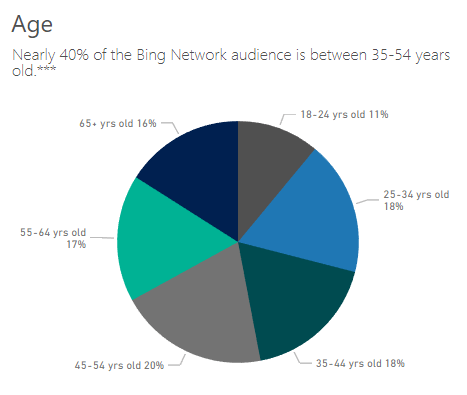
Also, about one-third of the Bing Network has a household income of over $100,000, and almost half of the Network has a household income of $75,000 or more:
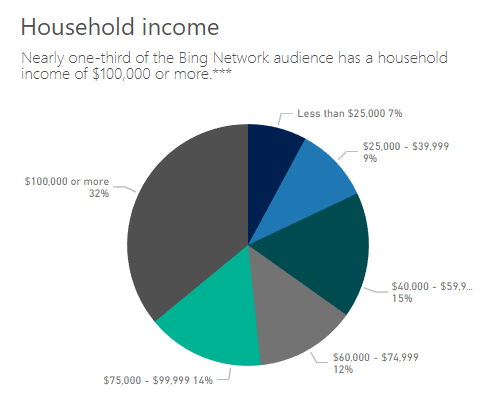
The point here is that despite Ads reaching more people and having higher search volumes, Bing allows you to reach a even wider audience — a specific demographic of customers — and produce even better results than simply AdWords alone.
Cost: Bing Ads vs. Google Ads
What Bing lacks in volume, it certainly makes up for in performance. Although budgets fluctuate by industry and every single advertiser, one particular digital marketing agency found that Bing only spent 20%-35% of their AdWords campaign equivalent:

This example is possible because Bing PPC has far less competition for advertisers bidding. So clicks are cheaper, and advertisers get more for their dollar.
According to ReportGarden, CPC averages $7.99 on Bing Ads and $20.08 on Google AdWords:
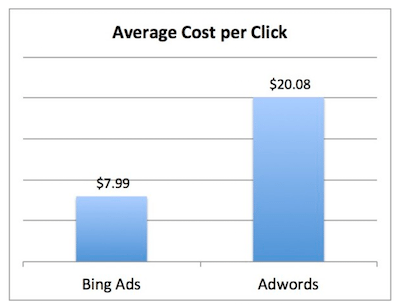
In fact, the average cost-per-click on Bing Ads can be up to 70% lower compared to Google Ads. A Search Engine People study found that in the automotive industry, CPCs were 32.5% lower on Bing PPC than Google, and in the insurance industry, 59.2% lower.
When comparing the costs of each ad platform, it’s important to remember that Bing and Google don’t always get the same traffic. In some instances, Bing Ads CPC is lower, but the traffic quality is also lower, so advertisers end up paying more for a conversion than they do on Google Ads. The opposite can also be true, though — with the right traffic, Bing PPC can generate more sales and at a lower CPC. Fortunately, since competition is lower on Bing, it’s easier to get the traffic you need at a low cost, resulting in better ROI.
More benefits with Bing PPC
Bing Ads isn’t just about extended reach, an older and higher-income audience demographic, less competition, lower CPC, and potentially better ROI. Other benefits come into play.
Import your Google Ads campaign
After creating a Bing Ads account, the platform offers advertisers the option to directly import their existing Google Ads campaigns into Bing Ads. With just a few clicks, your campaign is up and running without having to recreate everything from scratch:
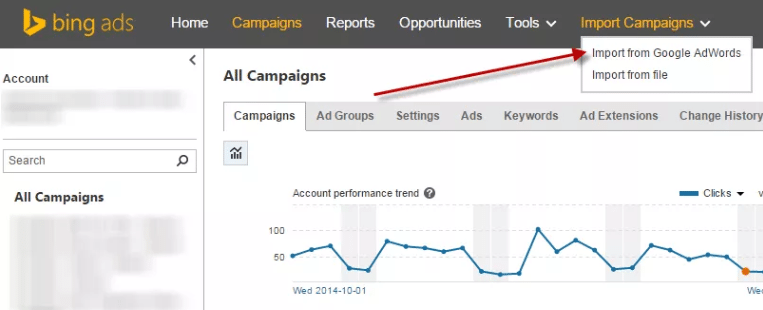
Increased granular control
Bing offers more granular targeting at the ad group level. While Google allows advertisers to set their network, location, language, ad scheduling, and ad rotation settings at the campaign level, the ad groups remain limited to their campaign-level settings. Bing Ads, on the other hand, allows for adjustments to be made at the ad group level as well. Bing also enables advertisers to assign different ad campaigns to different time zones — a function that Ads doesn’t offer.
Improved device targeting
Bing Ads has Google Ads beat with device targeting, because of how limited mobile ad targeting can be with Ads. Bing allows advertisers to target specific audiences based on their device type and OS. It also provides the option not to display campaign ads on desktops, when you only want to target mobile users.
Sitelink extensions
Just like Google Ads, Bing PPC offers advertisers a chance to add additional information that can persuade search users to click through. These extra links can vary from pricing, demos, content downloads, free trials, and more. Not every paid search ad is guaranteed to show sitelink extensions, so when they are displayed, they catch the user’s attention more because the overall ad is much larger than others in the SERP list.
Here is an example from Google Ads; “Pricing” and “Watch CRM Demo” are sitelink extensions with their own respective URL:
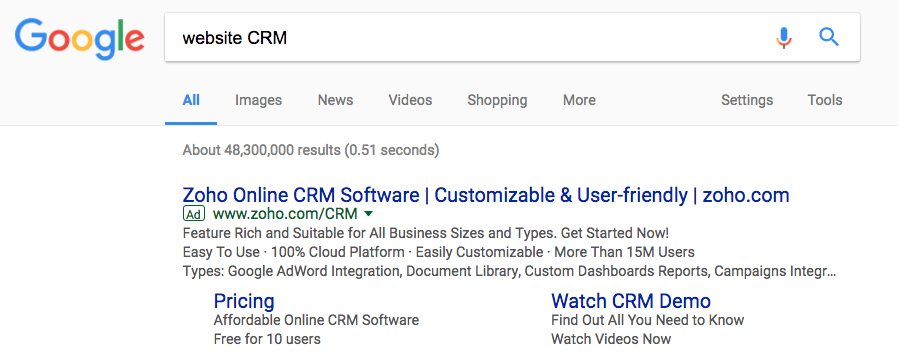
Greater transparency
Bing is fully transparent when disclosing details about its search partners, allowing advertisers to see exactly where their traffic is coming from. The platform provides detailed reports on the performance of each search partner in a campaign, including details on all metrics, from impressions to conversions.
Higher engagement and conversion rates
Bing users that click PPC ads tend to be more engaged with the sites and landing pages they’re sent to. They also convert at much higher rates. The Search Engine People study mentioned above found that in the automotive industry, users were converting at 10%-56% higher rates than Google ads.
The benefits of Bing Ads certification
Similar to Google Ads’ certification program, Bing Ads customers can take a training course followed by an accreditation exam (must score at least 80%), to receive a Bing Ads Accreditation. Once earned, displaying this badge can particularly useful when closing new business.
Hallam Internet marketing agency is an example of a brand that became Bing Ads certified. See the member badge on the bottom-right?
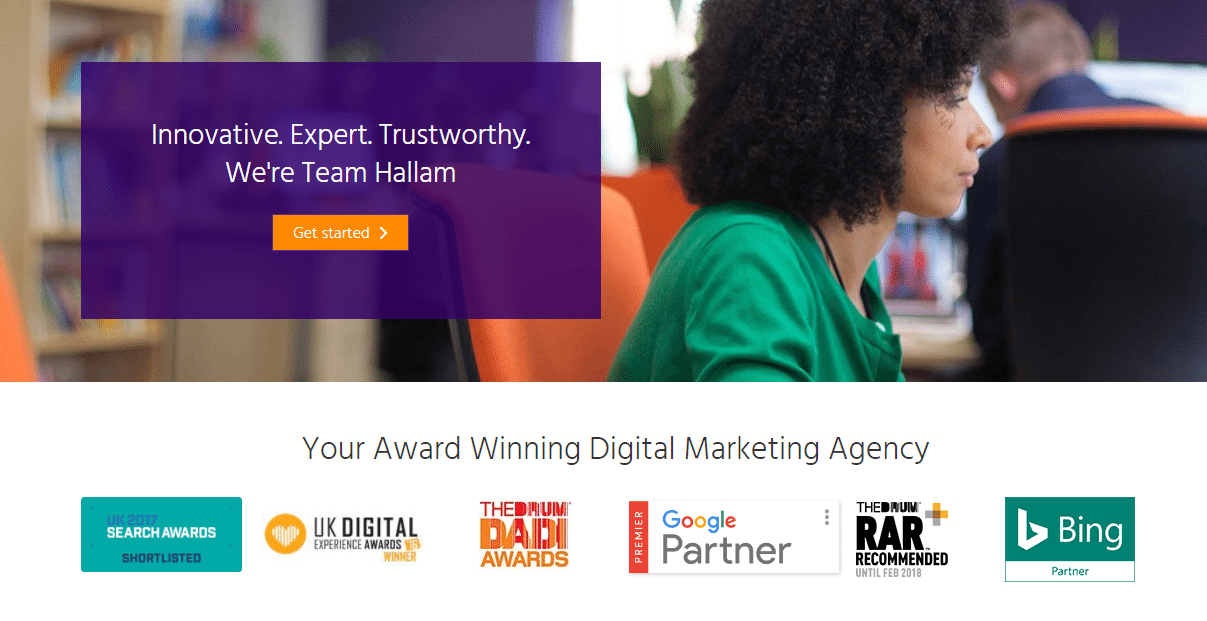
By becoming a Bing Ads Accredited Professional, advertisers gain several benefits, including:
- Recognition as a Bing Ads expert with an official member badge on websites, business cards, stationary, resumes, and other marketing materials
- Placement in the Accredited Professional membership directory
- Updated Bing Ads profiles that include social media platforms and sharing sites
- Resume-building
So, should you use Bing or Google ads?
Hopefully by now it’s understood the best digital advertising strategy is to leverage both platforms simultaneously, provided your budget allows it.
Google Ads may be top-of-mind with digital ads, but Bing is perfect for complementing your PPC strategy and filling any gaps in your online presence. With Bing Ads accompanying your Google Ads campaigns, you can expand the reach into new and unique territories. And even though Google has more search volume, Bing boasts higher positioning, less bidding competition, and generally a lower cost-per-click.
Refer to the Digital Advertising Reference Guide for the most up to date ad specs and targeting options. Then, use both Bing Ads and Google Ads to create persuasive ad campaigns, providing an optimal landing page from ad to landing page with Instapage — sign up14-day free trial today.
Keep learning
1. Breaking Down Bing Ads vs. Facebook Ads & the Pros & Cons of Each Platform

Try the world's most advanced landing page platform with a risk-free trial.
